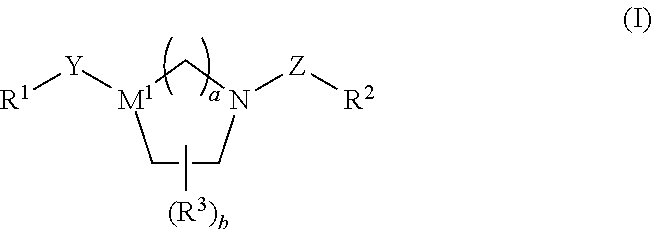Tricyclic Heterocyclic Derivatives and Methods of Use
a tricyclic heterocyclic and derivative technology, applied in the field of new drugs, can solve the problems of increased and premature morbidity and mortality, increased risk of macrovascular and microvascular complications in diabetic patients, and increased plasma insulin levels
- Summary
- Abstract
- Description
- Claims
- Application Information
AI Technical Summary
Benefits of technology
Problems solved by technology
Method used
Image
Examples
example 1
Preparation of Compound 1
[0299]
Step 1
[0300]
[0301]Sodium triacetoxyborohydride (1.4 g, 6.56 mmol, 1.5 eq) was added to a stirred solution of tert-butyl 4-oxo-1-piperidine carboxylate 1b (1.13 g, 5.69 mmol, 1.3 eq) and 6,7-dihydro-5H-dibenzo[c,e]azepine 1a (Synthetic Communications, 25 (23), 3901-6; 1995) (1.014 g, 4.375 mmol) in dry DCM (50 mL) at room temperature and the resulting mixture was stirred for 15 hours. Then the mixture was diluted with DCM and treated with sat aqueous K2CO3 solution. The layers were separated and the aqueous layer was extracted with DCM. The combined organic phase was dried, the solvent removed in vacuo and the residue purified using flash column chromatography on silica (DCM:0.4N NH3 in MeOH 95:5) to provide 1c (1.17 g, 70%) as a pale yellow foam.
Step 2
[0302]
[0303]A solution of boc-protected piperidine 1c (1.17 g, 3.09 mmol) in a mixture of dichloromethane (20 mL) and trifluoroacetic acid (5 mL) was stirred at room temperature for 20 hours. The mixture ...
example 2
Preparation of Compound 2
[0308]
Step 1
[0309]
[0310]Tetrahydropyran-4-carbaldehyde 2b (4.1 g, 1.0 eq) was added to a stirred solution of piperidine-4-carboxylic acid ethyl ester 2a (6.62 g) in dichloromethane (100 mL). The mixture was stirred at room temperature for 10 minutes. Then sodium triacetoxy borohydride (7.6 g, 1.0 eq) was added and the resulting mixture stirred for 15 hours. The mixture was diluted with dichloromethane (400 mL) and washed with act sat K2CO3 (300 mL). The layers were separated and the aqueous layer extracted with dichloromethane (2×300 mL). The combined organic phase was dried, the solvent evaporated in vacuo and the residue purified using flash column chromatography (SiO2, ethyl acetate) to provide 1-tetrahydropyran-4-ylmethyl-piperidine-4-carboxylic acid ethyl ester 2c (8.48 g, 86%) as a pale yellow oil.
Step 2
[0311]
[0312]Lithium hydroxide 1 N solution (17 mL, 1.2 eq) was added to a solution of the above ethyl ester 2c in THF (50 mL) and MeOH (35 mL) at room ...
example 3
Preparation of Compound 3
[0316]
[0317]Using compounds 1d (see Example 1, Step 2) and 2d (see Example 2, Step 2), and using the method described in Step 3 of Example 1, compound 3 was prepared. MS: (M+1) 506.
PUM
| Property | Measurement | Unit |
|---|---|---|
| temperature | aaaaa | aaaaa |
| temperature | aaaaa | aaaaa |
| temperature | aaaaa | aaaaa |
Abstract
Description
Claims
Application Information
 Login to View More
Login to View More - R&D
- Intellectual Property
- Life Sciences
- Materials
- Tech Scout
- Unparalleled Data Quality
- Higher Quality Content
- 60% Fewer Hallucinations
Browse by: Latest US Patents, China's latest patents, Technical Efficacy Thesaurus, Application Domain, Technology Topic, Popular Technical Reports.
© 2025 PatSnap. All rights reserved.Legal|Privacy policy|Modern Slavery Act Transparency Statement|Sitemap|About US| Contact US: help@patsnap.com



